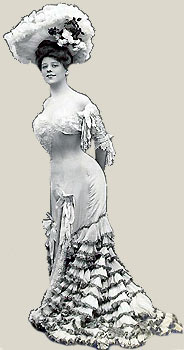Origin of Gibson Girl |
| Instruction Manual | Extract "Air Publication" | Home Gibson Girl (wokipi-kite) | |||
An RAAF survival radio transmitter carried by World War II aircraft on over-water operations was named the 'Gibson Girl’ because of its 'hour-glass' shape. It included a fold-up/down metal frame box kite for which the flying line was an aerial wire. A hand-crank generator provided power for the distress radio signal. Afterward, the name was for the Kite. The Gibson Girl was the personification of the feminine ideal as portrayed in the satirical pen and ink illustrated stories created by illustrator Charles Dana Gibson during over 15 years spanning the late nineteenth and early twentieth century. The Gibson Girl was tall, slender yet with ample bosom, hips and bottom in the S-curve torso shape achieved by wearing a swan-bill corset; she was fine-featured, and achingly beautiful.. The most famous Gibson Girl was probably the Danish-American stage actress, Camille Clifford, whose towering coiffure and long, elegant gowns wrapped around her hourglass figure and tightly corseted wasp waist defined the style. Charles Dana Gibson (1867 -1944) was an American graphic artist, noted for his creation of the "Gibson Girl", an iconic representation of the beautiful and independent American woman at the turn of the 20th century. The development of the "Gibson Girl" from 1890 and her nationwide fame made Gibson respected and wealthy.The popularity of the Gibson Girl faded after World War I, and Gibson took to working with oils for his own pleasure. |
 |